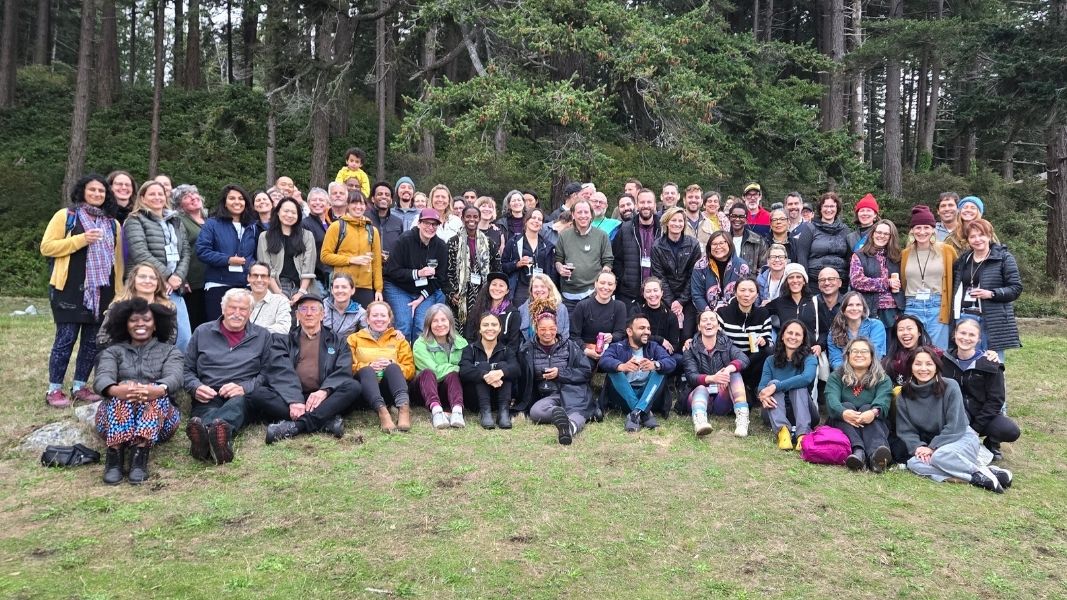Tantra is allowing the weaving of our senses and our material being with spirit. It is gently guiding the beautiful tapestry of our lives to unfold into liberation. It is experiencing the sacred matrix of interconnectedness with everything & everyone and understanding our mutual influence. It has both great freedom as well as responsibility.
– Yogacharini Maitreyi
During these COVID-19 housebound times, we are offered an opportunity to delve deeper into our lives and release unresolved emotions. We do not have to underestimate or ignore what collective uncertainty can do to us. Instead, we can learn and use tools that will help to deal with it.
One of the ways tantra allows us to stabilize, is that we learn to immerse and anchor in our bodies, breath, day to day life and senses. This reconnection paves the way for integration through gently releasing old emotional and mental fractures and trauma. These old traumas become like a wall that prevent integration of body, emotions, prana, mind and the higher consciousness.
Step By Step Understanding
Tantra is a sanskrit word, pronounced “thun-thra.” The “thun” sounds like “fun.” Please note the “th” sounds like the “th” in “thimble” or “thumb.” With “thra,” as well the “th” is soft and not a hard “t” as with “table.” When you google search “tantra pronunciation,” what comes up first, in the audio dictionary is disappointingly wrong.
“Tan,” or “thun,” means tangible, and “tra,” or “thra,” means to transcend. It is a tool kit and skill to both embrace and transcend the limitations of the material or tangible. Thereby, the tangible becomes a vehicle of the Divine.
“Tanoti” means to stretch or expand and “trayati” means to liberate. So tantra aids to stretch and expand our limited perceptions and experience of ourselves and life. We are liberated from unhealthy patterns and dysfunctional ways, in order to commune with our highest self or reality.
Sattvic Tantric practices allow this expanded experience in the body. “Sattva” is the quality of calm aliveness, the capacity for presence rather than restlessness or agitation (described in Sanskrit as the quality of “Rajas”) or stagnation and darkness (described in Sanskrit as the quality of “Thamas”). The dark side of tantra is not for liberation and technically not tantra. This is more in the realm of black magic, which people sometimes mistake to be tantra.
How can the limited body feel expansion? That is both the paradox and prize of tantra. Many in the Arkaya tantra yoga classes have felt this gentle awareness of prana and expansion.That’s why starting with a strong foundation and self awareness are important. The aim is not to escape the body or the material reality and at the same time, not get stuck in it. The strong foundation is created by self awareness and practices which are not part of western tantra unfortunately. This self awareness is not just part of a weekend workshop and requires long term commitment. These practices enable one to tap into ones multidimensionality and align with it.
Tantra brings deep awareness to the heart. This helps us to see the light in the heart as well as the shadows and darkness, the fear and pain. Then, these shadows may be acknowledged, embraced and transformed – this is tantra. That is where true ecstasy lies. It shines through better as layers and layers of emotional encrustations are dissolved. This releasing and allowing, not grasping, are essential to tantra. The electro-magnetic field of the heart is over 60 times the strength of the brain. That’s why we say, “may your heart’s desire come true.” We can magnetize things through the resonance of the heart.
Contemplating and executing healthy boundaries is also very important as those who open up too soon to the wrong environment or person can pick up emotions or external energies / entities that might hook on. These can masquerade as self if one is not careful. As we are careful about the foods we eat, careful not to step in slush or tar when we spot it, so must we be aware that there can be emotional and energetic cesspools that we are better off avoiding in certain contexts. However this comes from loving discernment and not condemnation.
Tantra in Sanskrit also means “weave.” We weave so-called opposites or polarities, like: shiva (consciousness) & shakthi (power), top & bottom, left brain & right brain, matter & spirit. We are not trapped in rigid confines of structure, linearity or fanaticism. This union leads to moksha or liberation. This beautiful tapestry of our lives can be consciously woven through tantra. We also see the interconnectedness of this fabric of life, this sacred matrix and experience these connections in our lives, seeing our mutual influence.
Tantra recognizes and embraces all the dimensions we exist in. We see a negation of different aspects of ourselves in different streams of thought. Tantra is a space where all the shadows can be seen and healed. We can consciously feel to heal. We see we are not just a physical being. We have a pranic or energy body, a mind field, a great (transpersonal) wisdom field to tap into, as well as other dimensions. These dimensions have specific Sanskrit names and there are a variety of tools to realign all the dimensions. With awareness and practice, one is always becoming more cohesive and harmonious.
Tantra is a dance of liberation. Tantra allows us to start the dance where we are with no judgement. It creates space for us to see the consequences for certain patterns that harm us or others. So we see the dance of head, heart and hands as a team towards liberation. Our gut, heart and mind are involved in the dance and no aspect is left out. This dance also includes other dimensions, as indicated above.
Tantra is a practice to savour source through the senses as well as refine the senses. It is not just a physical encounter, as propagated by western tantra, breathing exercises or some eye gazing thrown in to make it seem spiritual or exotic. It is a refined connection that the nervous system grows into, where it gets more out of less. The law of the senses is the law of diminishing satisfaction where the more the continued stimulation, the less the satisfaction. The more the mind is distracted, the less the presence. The more the trauma, the more the restlessness. So tantra works on releasing the suppressed emotions and trauma so one can be more present. This dancing oneself into dynamic stillness, for union, is the aim of tantra.
Typically one would study with a teacher and do practices that help to be more still and present, not get more agitated because of over-stimulating their nervous system. Sometimes in the name of tantra overstimulation and titillation is sold. This depletes the nervous system. Old traumas can come to the surface and one learns to resolve them, rather than run away, project onto others in the group or fight the facilitator when they bring awareness to a projection. This safe space for the group, where they do not have to deal with another’s projections, is important in any healing practice, including tantra.
Tantra also means a text or scripture. It is a sadhanashasthra. This means it is a practice oriented scripture.
Tantra is the dance of harmony, the embodiment of intimacy and the union of polarities
– Yogacharini Maitreyi
What Comes to Mind When the Word Tantra is Mentioned in the West?
The sexualized aspects are always in the forefront. Tantra is about spiritualizing everyday life, including sex, not sexualizing spirituality. Please do not confuse sex with intimacy. Tantra enables better intimacy with ourselves, the cosmos and others. Also, please do not confuse tantra with the Kama Sutra or Bollywood.
Sex is definitely a part of life and we need to learn to heal and release the collective guilt, shame, repression, immaturity, commoditization and obsession around it. Not only do we heal the thamas (density) and rajas (restless escapes), but also enable being uplifted by engaging consciously in it. The single most common misconception is that tantra requires a partner. However, tantra starts with balancing one’s own energies and polarities within. Therefore, by later engaging with a partner, the energy one brings will be purified and elevated and not from a place of entitlement or subservience. Another major benefit is that we learn to release energetic and emotional enmeshment in partnerships.
Many times in Western tantra I see people leaking sexual energy, spewing it over unsuspecting souls who either have to clear it or get pulled into the confused messages it sends out. This has many shades and is not what tantra is about.
How Do I Start on a Tantric Path?
-
Find a teacher who has worked for many years on refining their nervous system and embodying grace. The guide is given a lot of importance on the yogic and tantric paths as there is much room for misinterpretation. For example, one can become self-centred rather than being centred in oneself, become money minded instead of being mindful of money, disconnected rather than detached or confuse servility with humility. Walking this path is said to be like walking the razor’s edge. However, it gets easier when one refines one’s impulses and discernment.
-
Start step by step to engage more consciously with your own body as well as with the everyday physical world. Fully inhabit your body. Practice savouring your food, your bed, your home, your bath, the sun, the earth, your body, your breath, etc. Savour your senses.
-
Set aside time to refine your senses and re-sensitize, so you can get more out of less and dissolve the devouring mentality – be it while consuming food or engaging in sex. These practices include being mindful, practicing pranic breath work, various tantric mudras, rituals, etc. to cultivate restraint, containment and connection. This helps fill the container of both the feminine and masculine, rather than deplete. This is very different from repression.
-
Have patience and don’t rush the process or grasp for an experience.
-
Tap into presence and prayer, be it a bodily prayer as with a practice or thought prayer to connect to source.
-
Be aware of how you are spending your energy and create loving conscious boundaries, before melting boundaries.
-
Tantra is about energy containment and healthy expression. The same holds true for sexual energy. Please do not confuse a teenager’s expression of sensuality and flaunting with tantric practice.
-
Tantra provides a space for compassionate witnessing and accountability, being aware of the consequences of our thoughts and actions.
-
Tantric practices help disentangle from one’s self-worth being tied to looking important, one’s roles, or one’s social standing or status.
What to be Aware of On This Path
-
We may come expecting bliss, while our old traumas, fears and pain come to the surface instead. This can be scary or disappointing and hence a step by step approach is needed. However, when you resolve it, you and others will be able to connect to the real you rather than your trauma masking as you.
-
When we engage intimately we are opening ourselves to resonate with the energy of our partner. This leaves room for unregulated nervous energy to be transferred. There is also transference of energetic aberrations if one does not have healthy boundaries. So as much as we love everyone we do not have to accommodate everyone.
-
Overstimulation of the senses, the sex drive or any drive due to an imbalanced nervous system created by constant indulgence. Mistaking addiction for elevation.
-
Avoid studying with gurus or teachers who insist on having sex with you or those who have studied with or emulate such gurus. They will leak this seductive or bullying energy and not be aware of it. This is one of the worst things that has happened to tantra. None of my gurus asked for sex nor attempted to penetrate me – either with their genitalia or eye gaze. Even if people misunderstand a tantra teacher to be a sex therapist, the sex therapist does not sleep with the client or ooze their sexual slime onto the client. This way of looking at and practicing tantra will create more harm than good Even if there is no overt sexuality, sticky emotional attachments have to be cleansed.
-
The same stands for students of tantra. They should understand that this requires one to take responsibility for one’s energy and see if it is contained and shared in healthy and mutually respectful ways or if it is being projected.
-
There can be partial kundalini experiences due to the tantric practices that move prana. If it is disturbing or painful it is time to tone it down. In the Arkaya system the class is structured in a way where the energy moves to clear the nadis or pranic pathways. It is gentle and allows the kundalini experience to happen in a natural way. In this structure people see their dysfunctionalities and buried shadows first. This prevents them from misusing the siddhis or powers they may gain due to the partial kundalini experience.
This is a beautiful organic path where you can water your thirst for wisdom, fan your flames of clarity and be deeply touched by life by facing your fears and resolving them. This is even more relevant during COVID times and please see our online programs on offer below to support you in this glorious journey of becoming more human and humane.
Yogacharini Maitreyi does an online community class every Saturday on Zoom from 11 AM to 1 PM PST. This is an opportunity to connect with lightness & restfulness from the comfort of your home, with a practice, talk, and Q&A. Learn more here.










